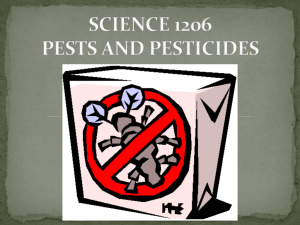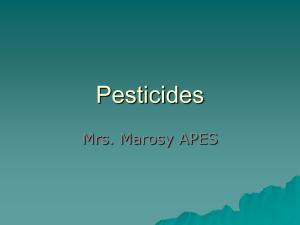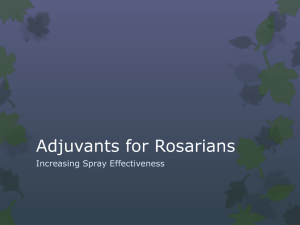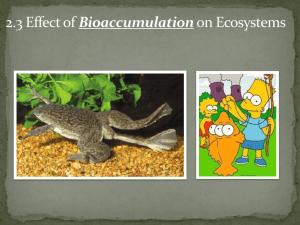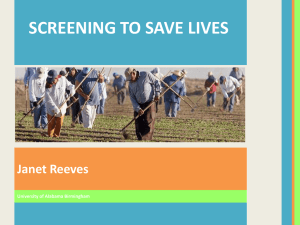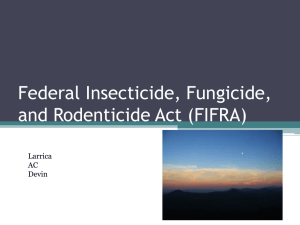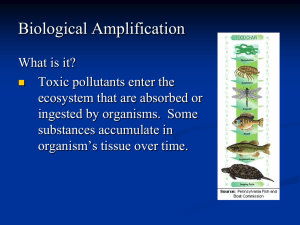Food chemical safety
advertisement
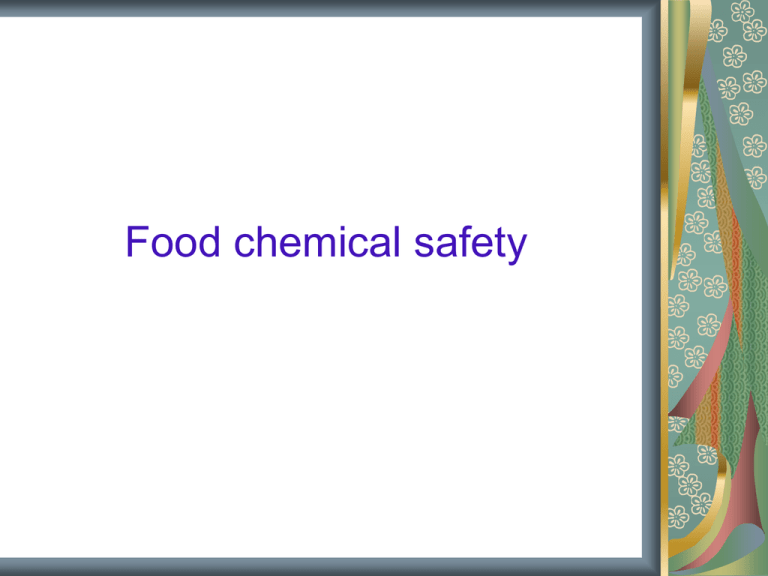
Food chemical safety Chemical contaminants in foods Characteristics: They are not added intentionally added to food. Contamination can happen at one or more stages in food production. Illness is likely to result if consumers ingest enough of them. The above differentiate from other chemicals in food such as vitamins and additives. Examples of chemical contaminants Pesticides Herbicides Fungicides Veterinary drugs Pesticides “eat your fruits and vegetables” is one of the recommendations for a healthy diet. Use of pesticides and chemicals to protect fruits and vegetables against insects and pests, and moulds. Correct and responsible use of pesticides can enhanced yield and safety of these produce. Use of pesticide Must follow the limits sets by the Ministry for use on food commodity, and the safe amount of pesticide residue that may be present at the point of sale. The safe residue level conform with the international standards set by Codex Alimentarius Commision. Potential hazard? Pesticide residue. Contamination of surface and ground water. Persistent pesticide not degradable are removed from the registration list. Acceptable Daily Intake (ADI) ADI is a measure of toxicity. Calculated from a known toxicological effect of a chemical (e.g. pesticide), example: increased serum glutamate pyruvate aminotransferase (SGPT) in dicator of liver damage. The dose of the pesticide below the point at which the defined toxicological effect occurs in animal studies is determeined (NO Observable Adverse Effect Level – NOAEL). This is the maximum dose that can be consumed without any adverse effect resulting. ADI exceeds the level is rare, but cases of lindane in milk (UK in1996) and chlormequat in pears in 1999. Maximum Residue Level (MRL) MRL is not a toxicological parameters but a trading standard set by national and international authorities (e.g. Codex Alimentarius) to ensure that residues are controlled in world food trade. MRL is the pesticide residue level in particular food following its production according to Good Agricultural Practices (GAP) i.e. apply pesticide at the right time and according to label directions, appropriate withdrawal period (time necessary between application of pesticide and harvest); the crop is harvested and residue determined. If the level of pesticide exceed the MRL, the crop has not been grown according to GAP and the product not permitted to be sold, imported or exported. Exceeded the MRL has no health implication, but the farmer has breached the national or international regulations and is liable for prosecution. Exceeding the MRL is more common. Pesticides must be in harmony with non target pests and environment. Those broad-spectrum pesticides and have long residual effect were either removed from the market or restricted usage. The regulatory body is Pesticide Board of Malaysia under the preview of the Ministry. Pesticides withdrawn or partially banned by the Pesticide Board of Malaysia Aldrin Diledrin Benomyl Chlordane DDT Heptochlor Penthachlorophenate Endosulphan withdrawn by the parent company ------do-----------do----total ban total ban total ban partial ban – not allowed for paddy partial ban – not allowed for cocoa and pepper Lindane (gamma-BHC) partial ban – allowed for palm oil and coconut only (total 17 pesticides) Pesticides not allowed for use on vegetables Some organophosphate pesticides, e.g. methamidophos and monocrotophos, were registered for use in vegetables but after review by the Pesticide Board, they have been banned based on their residue or toxicology problems. All pesticides use in Malaysia must be registered. Comply the Pesticide Act 1974 and Food Act 1985, for the registration, production, management and application of pesticides. DDT : organochlorine (1,1’-(2,2,2-trichloroethylidene)bis(4-chlorobenzene) Dr. Paul Muller, a Swiss chemist won an Nobel Prize in Medicine in 1948 for DDT, replacing extremely dangerous chemicals for pest control (arsenic, lead and mercury). Effective against mosquitoes causing malaria, kill lice, improve health in Sri Lanka. 1964 use of DDT was discontinued in Sri Lanka, and coincide with publication of Carson’s Silent Spring. Attack on DDT: (i) cause thin egg shells. (ii) DDT is so stable and could never be eliminated from the environment. Safe for human? Cancer? (lipid solubles) Repeated administration of DDT to animals results in tremor, incoordination, muscular twitching and weakness. DDT is excreted in urine. Organophosphate (OPs) Oldest synthetic pesticides. Common names: organic phosphates, phosphate insecticides, phosphorus esters or phosphoric acid esters. Genarally speaking they are most toxic to vertebrate animals. Mode of action is similar to nerve gas (potent cholinesterase). Attack nerve, death as a result of respiratory failure. e.g. malathion, parathion. easily metabolized by esterase,low mammalian toxicity. Residues in food products do not normally result in exposure sufficient to lead to health problems in humans. Pyrethroids “green” pesticide from chrysanthemum (pyrethrum). Other insecticides Carbamates similar to Ops, water solubles, contaminated water. mode of action; similar to Ops cholinesterase inhibitors. Cyclodiene: e.g. aldrin and dieldrin, stable in soil and relative stable to uv of sunlight. Use to control soil insects. Mode of action is neurotoxicity. Herbicides Weed killers. Trace residues present in final food products. Chlorophenoxy acid esters: 2,4-D and 2,4,5-T No apparent adverse effects on human and animals. The 2,4,5-T used in Agent Orange contains excessive amounts of tetrachrodioxin, suspected toxic impurity. Bipyridyliums: paraquat and diquat. On contact plant tissues are quickly damaged. Cases of accidental or suicidal fatalities from paraquat poisoning. Fungicides Chemicals used to kill or stop the development of fungi. To treat plants, roots,seeds Industrial and environmental contaminants Most do not pose threats to human, but some certain incidences have indicated that they can be a potential hazard. Halogenated hydrocarbons: polychlorinated Biphenyls (PCBs) or trade name Aroclor ® first synthesise in1881. Uses: insulating fluids in electrical industries, food packaging made from recycled paper, paints, lubricants, insulating tapes, fireproofing materials, and ink. Considerable resistant to acids, bases, high temperature, electrical current and is nonflammable. Safety: no significant health threats to human. Dioxin TCDD (tetrachlorodibenzo-p-dioxin) are among most potent toxicants known, chemically very stable and binds strongly to to solids or particulate matter in soil, is lipophilic but sparingly soluble in water or organic liquids. LD50 for TCDD in guinea pig is under 1 mg/kg; hamster is more than 10g/kg. Toxicity affect the kidney and skin, promoter of carcinogenesis and is a carcinogen. Liver tumors, tumors of the mouth, nose and lung have been found. Three times more potent than aflatoxin B1. In rhesus monkeys, TCDD is fetotoxic, resulting in higher levels of abortion and death in pregnant females. Human exposure: no fatalities, toxic effects include fatigue, affect peripheral nervous system and liver toxicity. Heavy metals Mercury: exists in many forms. metallic mercury, inorganic mercury compounds or salts, organic mercury compounds. Nervous system is very sensitive to all forms of mercury. Exposure to high levels of metallic, inorganic or organic mercury can permanently damage the brain, kidneys and developing fetus. Mercury chloride and methyl mercury are possible human carcinogens. Children are more sensitive to Children are more sensitive to mercury than are adults, can be passed through breast milk. Mercury level in water FDA maximum permissible level of 1ppm methyl mercury in seafoods. EPA mercury in drinking water 2 ppm. Lead Previously, this heavy metal was found in a variety of consumer products (lead-based paints, antiknock petrol, lead-glazed glasses, lead water pipes, lead glazes, lead solders). Lead poisoning is normally due to occupational situations. Children are most affected, lead absorption in children is about 40%, adult 10%, highest in the bone. Anemia, neurological disorders in developing children brains, can pass from placenta to fetus. Elimination or minimize exposures. Cadmium Cadmium in food is as inorganic cadmiun salts. Organic cadmium is unstable. In Japan, chronic cadmium intoxication over 12-yr period occurred in some population that consumed rice contaminated with cadmium because of pollution. Painful disease called itai itai meaning “ouch ouch” bone disease, with symptoms of skeletal deformation and multiple fractures. Cadmium stays in the liver and kidneys. Breathing air with very high levels of cadmium can severely damage the lungs and cause death. Arsenic Found as inorganic and organic compounds. In foods, drinking water, wine and other sources. Used widely in manufacture of glass to remove green colour cause by impurities. Previously arsenic is used to treat syphilis until penicillin and other sulfa drugs were developed. Arsenic is abundant in seafoods, but in an organic form, not toxic, rapidly absorbed and excreted in the urine and bile. Classical syndromes of chronic arsenic exposure include hyperkeratosis, corns and warts on the feet and hands. May be indirect carcinogen. 10 to 50 ppb may be necessary to maintain homeostasis of the body, used successfully to treat acute promyelocytic leukemia (APL). Standard in drinking water is 10ppb. Contaminants of Industrial and Environmental Origin CHEMICAL Polychlorinated biphenyls SOURCE Electrical appliances ASSOCIATED FOOD Fish, animal fat Dioxin Impurity Fish, milk, beef fat Mercury Chlor-alkali Fish Lead Vehicle emission, smelting, paint, glazes, solder Vegetables, canned food, canned dish, acidic food Cadmium Sludge, smelting Radionuclides Accidental release Grains, vegetables, meat, molluscs Fish, mushrooms Contaminants of Biological Origin (Inherent Plant Food Toxicants) CHEMICAL Oxalates Glycoalkaloids Cynide Phytohaemagglutinin Various carcinogens ASSOCIATED FOOD Tea White potato (solanine) Cassava, Lima beans Red kidney beans and other beans Herbs, spices Contaminants of Biological Origin Mycotoxins CHEMICAL SOURCE ASSOCIATED FOOD Aflatoxin Aspergillus flavus and A. parasiticus Corn, peanuts, copra, milk Trichothecenes Mainly Fusarium spp Ochratoxin A A. ochraceous Cereals and other foods Wheat, corn, barley Ergot alkaloids Claviceps purpurea Barley, wheat Patulin Penicillium claviforms Apples and other fruits Zearalenone Fusarium spp Cereals, oils, starch Minimum Water Activity for Growth of Toxigenic Moulds Mould Aspergillus flavus Aspergillus ochraceus Penicillium griseofulvum Minimum Aw 0.81 0.78 0.83 Target Organs of Some Mycotoxins Mycotoxin Target Aflatoxin Ochratoxin Trichothecenes Ergot alkaloids Liver Kidney Mucosa Peripheral vascular system Uro-genital tract Zearalenone Regulatory Limits for Mycotoxins in Foods Mycotoxin Aflatoxins B and G Aflatoxin M1 Ochratoxin A Deoxynivalenol Patulin Zearalenone Limit (ppb) Commodities 0 - 50 10 – 1000 0 – 0.5 1 – 300 All foods Animal feeds Milk, dairy Rice, corn, barley, beans, pork kidney 1000 – 4000 Wheat Apple juice 20 – 50 30 - 1000 All foods Regulatory Limits for Aflatoxins in Some Asian Countries Country China Hong Kong India Japan Malaysia Philippines Singapore Sri Lanka Thailand Limit (ppb) 50 20 15 30 10 10 20 Absence 30 20 Commodity Peanuts Peanuts Other foods All All All All All Peanuts All Other Toxicants of Biological Origin Chemical Source Associated Food Ciguatera Dinoflagellates Tropical fish Shellfish toxins: Dinoflagellates Shellfish Paralytic, neurotoxic, diarrheic and amnesic Pyrrolizidine alkaloids Various toxic plants Cereals, honey Histamine Spoilage bacteria Fish, cheese Contaminants Produced During Processing Polynuclear aromatic hydrocarbons Heterocyclic amines, nitropyrenes Nitrosamines Oxidized fats Ethyl carbamate (urethane) Improperly Used Agrochemicals Pesticides: Organochlorine insecticides Organophosphorus insecticide Carbamate insecticides Other pesticides Animal Drugs: Antimicrobials Growth promotants Anthelminthics Therapeutics Fumingants Fertilizers Nematocides Fungicides Herbicides Molluscicides Plant growth regulators Rodenticides Biotechnology Direct Food Additives (Improperly Used Additives) Anti-caking agents Antimicrobial agents Antioxidants Colours Curing and pickling agents Emulsifiers Enzymes Firming agents Flavour enhancers Flavourong agents Humectants Leavening agents Release agents Non-nutritive sweeteners Nutrient supplements Nutritive sweeteners Oxidizing and reducing agents pH control agents Propellants and gases Sequestrants Solvents and vehicles Stabilizers and thickners Surface-active agents texturizers Indirect Food Additives (improperly used) Processing Aids Ion-exchange resins, filter aids Enzyme preparation Microorganisms Solvents, lubricants, release agents Specific function additives Food Contact materials Utensils Working surfaces Equipment Packing materials Metals, plastics, paper, wood, etc. Cleaning Agents Detergents Sanitizers Adultrants Borax Boric acid Formaldehyde Unapproved colouring agents. Monitoring Points for Chemical Hazards Point source Environmental compartments Primary production Import/export Production and processing Consumer level Biomonitoring Criteria for Establishing Priorities Severity of potential effects on health Levels in individual foods and the diet Size and susceptibility of the exposed population Significance in domestic and international trade Nature and cost of management options Chemical Hazards in the Home Contaminated food and water Metal cookware contaminated with heavy metals Ceramic serving dishes with toxic glazes Leaded crystal used with acid foods Miscellaneous home-use chemicals Exposure Chemical Hazards in Food Areas of Concern Toxicity Potential Physical Hazards Glass Slime or scum Metal Bone Plastic Stones and rocks Capsules or crystals Pits or shell Wood Paper Distribution of Complaints of Foreign Objects in Foods Soft drinks Infant foods Bakery Chocolate and cocoa products Fruits Cereals Vegetables Fish Others 19% 16% 14% 7% 7% 5% 4% 3% 25% Possible Control Measures Visual inspection Filters or sieves Magnets Separation by density Personnel precautions Assignment: search for literature for reports on interaction of selenium and heavy metals.


